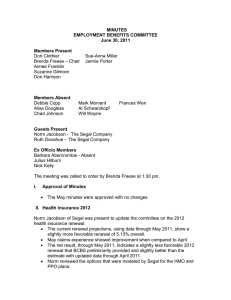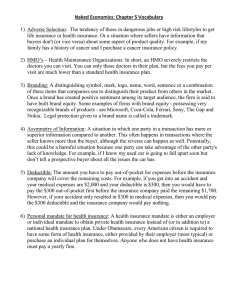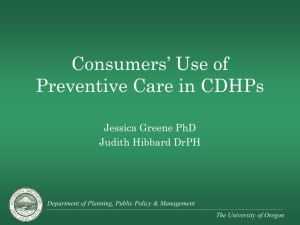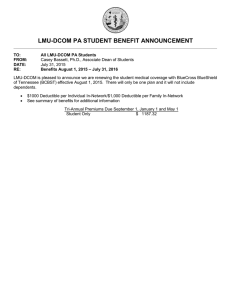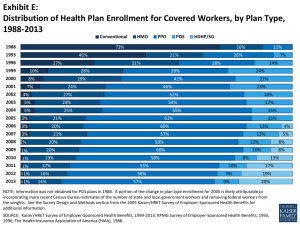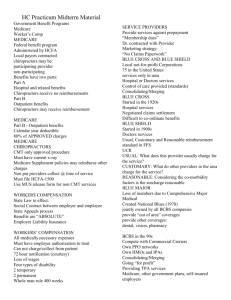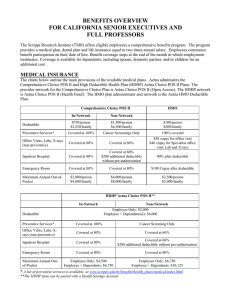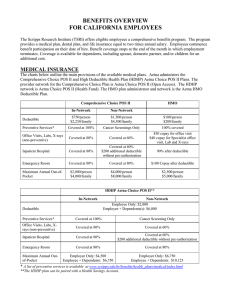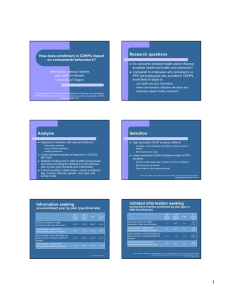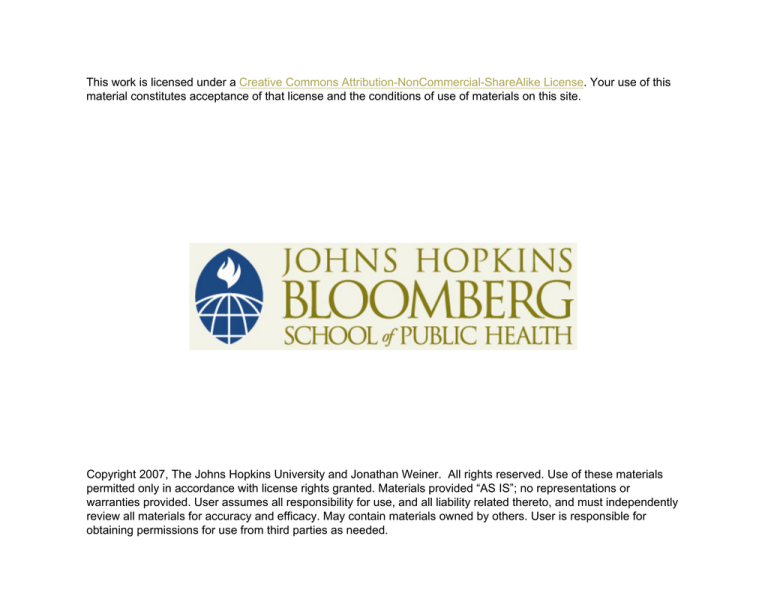
This work is licensed under a Creative Commons Attribution-NonCommercial-ShareAlike License. Your use of this
material constitutes acceptance of that license and the conditions of use of materials on this site.
Copyright 2007, The Johns Hopkins University and Jonathan Weiner. All rights reserved. Use of these materials
permitted only in accordance with license rights granted. Materials provided “AS IS”; no representations or
warranties provided. User assumes all responsibility for use, and all liability related thereto, and must independently
review all materials for accuracy and efficacy. May contain materials owned by others. User is responsible for
obtaining permissions for use from third parties as needed.
Session 4
PPOs, CDHPs and Other
MCOs
Jonathan P. Weiner, Dr. P.H.
Professor of Health Policy & Management
The Health Insurance Models
• Traditional (Fee-for-Service) Indemnity
• “Managed” Indemnity Plan
• Preferred Provider Organization (PPO)
• Health Maintenance Organization (HMO)
3
A Taxonomy for Determining the Type of
Health Insurance Plan
Type of Plan
Dimension
FFS
MIP
PPO
Financial Risk
for Payer
-/+
-/+
-/+
Financial Risk
for Intermediary
+/-
+/-
Financial Risk for
Physicians
-
Restriction on
Consumer’s Selection
of Provider
-
EPO
POS
HMO
-/+
-
-
+/-
+/-
+
+
-
-
-
+
+
-
+/-
+
+/-
+
4
Taxonomy - continued
Type of Plan
Dimension
FFS
MIP
PPO
Significant Utilization
Controls Placed on
Provider’s
Practice
-
+
+
Plan Obliged to
Arrange for
Care Provision
-
-
+/-
EPO
POS
HMO
+
+
+
+
+
+
5
Patients like their “freedom”
Percent of privately insured adults, by type of health plan, who say they
are worried that if they become sick, their health plan would be more
concerned about saving money than providing the best treatment
Very
Worried
Somewhat
Worried
Not Too
Worried
Not at All
Worried
All Plans
24%
32%
25%
18%
Managed Care
25%
34%
25%
16%
Strict MC
31%
36%
21%
11%
Loose MC
21%
32%
28%
19%
Data Source: Kaiser Family Foundation/Harvard School of Public Health National Survey on
Consumer Experiences With and Attitudes Toward Health Plans, August 2001 (conducted JulyAugust 2001).
6
Employers Reasons for Choosing Plans
Percentage of All Firms That Say the Following Features Are Very
Important When Choosing a Health Plan, 2003
90%
80%
70%
60%
50%
40%
30%
20%
10%
0%
80%
66%
54%
46%
46%
45%
19%
3%
Cost of Plan Number of
physicians to
choose from
Range of
benefit
options
1%
HEDIS
NCQA or
Tiered
Accuracy & Internet tools Measurable
performance
URAC
speed of to help with employee physician or
scores
hospital accreditation
enrollment satisfaction
claims
status
benefits
and claims
payment
processing
Source: Kaiser/HRET Survey of Employer-Sponsored Health Benefits: 2003
7
Shift in Employment-Based Plan Type
1988 - 2002
HMO
POS
PPO
100%
14%
90%
9%
8%
38%
41%
25%
22%
7%
5%
48%
52%
22%
18%
23%
26%
2001
2002
27%
80%
46%
70%
60%
Indemnity
35%
73%
28%
50%
26%
40%
14%
24%
31%
27%
28%
29%
1996
1998
1999
2000
30%
20%
10%
11%
16%
7%
21%
0%
1988
1993
Source: Kaiser/HRET Survey of Employer-Sponsored Health Benefits, 2002
8
Small Employers Usually Offer One Plan
Public Total
Private Other
Private Insurance
100%
80%
60%
40%
20%
0%
All Firms
Small
Midsize
Large
Jumbo
90%
91%
50%
37%
23%
Private Other
7%
7%
23%
23%
18%
Public Total
3%
2%
27%
40%
59%
Private Insurance
Employer Health Benefits, 2001 Annual Survey, The Kaiser Family Foundation and Health
Research and Educational Trust, Exhibit 5.3, p.63. See www.kff.org .
9
Small Employers Usually Offer One Plan
Public Total
Private Other
Private Insurance
100%
80%
60%
40%
20%
0%
All Firms
Small
Midsize
Large
Jumbo
90%
91%
50%
37%
23%
Private Other
7%
7%
23%
23%
18%
Public Total
3%
2%
27%
40%
59%
Private Insurance
Data Source: Employer Health Benefits, 2001 Annual Survey, The Kaiser Family Foundation
and Health Research and Educational Trust, Exhibit 5.3, p.63. See www.kff.org .
10
PPO Ownership and Enrollment
Ownership
-
% Plans
Insurance Co.
For-Profit
Provider
“Other” *
HMO
* Employer,multiple,TPA,Misc.
61
10
12
8
9
% Members
50
37
7
4
2
Source: Aventis -2006
11
“Gate-Keeper” PCP Model
• Model used in most other nations.
• Research evidence generally supports positive
findings.
• Still very common in many HMOs but there is
move towards “open access” in many plans.
• “Primary care case management” (PCCM) is
gatekeeper” model without the HMO structure.
12
Other Unique Plans
• Direct Contract MCOs
– Mainly providers who serve Medicaid or Self
Insured (sometimes called “PSOs – provider
sponsored organizations)
• EPOs
– Can be considered HMOs without the “risk”
generally ERISA based and similar to above.
13
Other Hybrid Plans
• Triple (or double) Option
– Employer offered more than one plan under
single MCO umbrella (Term also used for plan
with choice at the point of service)
• “Tiered” Plan
– Employees pay more up front for “more
desirable” providers (Could be part of CDHP)
14
Consumer-Directed Health
Plans (CDHPs)
(Derived in part from presentations by Joanna CaseFamadas and Erin Rand Giovannetti )
A Brief History of Major Health Plan Trends
FFS
HMO
Provider
Dominance
MC
Open
Access
Product
Development
Rising
Costs
Consumer
Driven HC
Rising Costs
MC
Backlash
Increased
“Consumerism”
16
Key Characteristics of CDHPs
• Flexible structure allowing consumer up-front
decision-making at many levels
• Financial incentives / disincentives directed at the
consumer, usually linked to high deductible and
“donut holes”
• Information that enables consumers to make
decisions (usually web based)
• CHDPs generally grafted on to “conventional” PPO,
EPO, Triple Option Plan, or Tiered plan.
17
Today, most CDHPs involve high deductible
health plans (HDHPs) and special taxprotected “accounts”?
•
Most CDHPs involve a Health plan with a high deductible
accompanied by a consumer-controlled savings account for
health care High deductible health plan (HDHP) typically has
deductible of at least $1000 for single coverage, but can be
much higher
– Two primary types of health care savings accounts
• Health Savings Accounts (HSAs)
• Health Reimbursement Arrangements (HRAs)
• To some CDHP and HDHP are synonymous
18
How Spending Accounts Work
1.
Employee uses money in the account for
qualified health care expenditures (“first-dollar”)
2.
When the money is exhausted, the employee
pays out-of-pocket until they meet the
deductible for their health plan.
3.
When out-of-pocket spending reaches a certain
limit, the plan kicks in and covers 80% of the
costs.
19
How CDHP Works:
Spending Accounts
Benefit Payment
Catastrophic Insurance
100%
(Plan Liability)
$7,000
80%
(Plan Liability)
Employee OOP
20%
Employee
Cost Sharing
$2,000
Employee Cost Sharing
(Employee Gap)
$1,000
Account Payment
Preventive
Services
20
HSAs vs HRAs
• Health Savings Account (HSA)
– Part of Medicare
Modernization Act
– Must have high deductible
plan
– Employers and employees
can put money into account
tax free (up to a certain
amount)
•
Health Reimbursement
Arrangements (HRA)
– Part of IRS
regulations
– Sponsored by
employer
– Offered in
conjunction with
high deductible plan
– Only employers can
put money into
account
21
Federal requirements for HDHPs offered with HSAs,
2006
• Deductible of at least $1,050 for single coverage and at least $2,100
for family coverage
• Annual limit on out-of-pocket expenses (for in-network services) of
$5,250 for single and $10,500 for family coverage
• Cannot cover services before deductible has been satisfied (other
than preventive care)
– IRS has been liberal in permitting services (including some
maintenance prescription drugs) to be considered preventive
• Can be provided by an employer or purchased directly from an
insurer (non-group health insurance)
22
23
Adoption: How Many?
• Estimates vary, but suggest that 2-3% of workers
are in a CDHP or HDHP
– America’s Health Insurance Plans (AHIP)
estimates 3.2 million enrollees in HRA/HSA plans
in 1/06
• Plans with a personal spending account are the
fastest growing
24
Large Employers Most Likely to Offer HDHPs
Share of Firms Offering HDHP, By Firm Size, 2005
33%
20%
20%
20%
Small (3-199 Midsize (200- Large (1,000Workers) 999 Workers)
4,999
Workers)
20%
Jumbo
(5,000+
Workers)
All Firms
HDHP has annual deductible ≥$1,000/ individual and $2,000/family. Prevalence shown
is for all HDHPs, regardless of offer with HRA, HSA qualified, or neither.
Source: Kaiser/HRET Survey of Employer-Sponsored Health
Benefits, 2005.
25
Evidence: Costs for Consumers
• CDHP costs (including OOP) between HMO
(lowest) and PPO (highest) in 2-year study of
large employer1
• Likely to spend > 5% of their income on health
care2
– 42% in HDHP
– 31% in CDHP
– 12% in traditional plan
1.
Parente et al “Employee Choice of Consumer-Driven Health Insurance in a Multi-Plan, Multi-Product Setting” HSR
2004;39(4):1091-1111.
2. Fronstin P and Collins SR “Early Experience with High-Deductible and Consumer-Driven Health Plans: Findings from
EBRI/Commonwealth Fund Consumerism in Health Care Survey” EBRI Issue Brief, December 2005.
26
Evidence: Impact on Consumers
Treatment Adherence Problems (due to cost)
Other
Privately
Insured (%)
HDHP/
HSA
(%)
Had a specific medical problem but did not
visit the doctor
17
33
Took medication less often than I should have
14
29
Did not fill a prescription
15
28
Did not receive a medical treatment or follow
up recommended by a doctor
17
28
Did not get a physical or annual check-up
19
25
Took a lower dose of a prescription than my
doctor recommended
15
19
Source: Harris Interactive, cited in CMWF “High Deductible Health Plans and Health Savings Accounts: For Better or
Worse?” January 27, 2005
27

